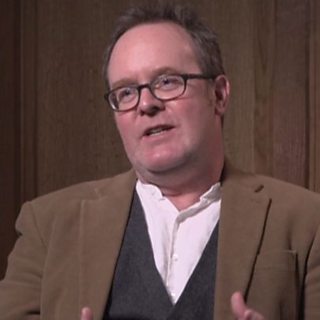Image: Radio 4 continuity announcers in the Broadcasting House Council Chamber in December 1973: left to right Jean Challis, Sheila Tracy, Peter Lee, Peter Donaldson, Paul Harris, Dennys Jones, Michael de Morgan, Brian Hudson, John Marsh, Brian Emprington, Brian Martin, Colin Doran, Roy Williamson.
For the ����ý, pop music wasn’t the only new sound of 1967. There was also the spontaneous verbal patter of Radio 1’s young DJs, whose informality seemed the very antithesis of the old Home Service and Third Programme way of doing things. Was a wider revolution in presentational values now under way across the ����ý?
Many listeners thought so – and weren’t at all happy. The older generation in particular had long viewed the ����ý as a guardian of the spoken word. Their ideal was the cool, detached voice of Alvar Lidell, who’d come to national prominence reading the wartime news.
Their fear was that his rigid standards were now being abandoned as the ����ý tried to be “with it” – a sign, some even said, of national moral decline. In the years following Radio 1’s launch, thousands of letters poured into Broadcasting House complaining repeatedly about poor delivery, errors in grammar or pronunciation, “sloppiness” and “gibberish” spreading across the airwaves.
Many ����ý insiders viewed such correspondents as linguistic “hangers and floggers” who refused to recognize the changing world and the ����ý’s need to change with it. Back in the 1930s, the writer Compton Mackenzie had accused the Corporation of sounding unbearably prissy, exuding what he called “finicking, suburban, synthetic, plus-fours gentility”.
It was the ����ý’s well-placed fear of being trapped in the past and failing to speak in a way that felt natural to most licence-fee payers which had encouraged a slow loosening-up in approach ever since: a brisker delivery, giving presenters more room to express their personality, and allowing the odd regional accent.
The pace of change had undoubtedly quickened in the 1960s. Radio 4’s bulletins now had shorter pieces from the newsreader and more clips from “real people”; producers were asked not to edit-away all the natural hesitations from recorded interviews.
Old habits die hard, of course. And radical upheaval usually went down badly with listeners. Libby Purves recalled still finding a “nervy perfectionism” when she joined in 1971: informality, it seems, was a work-in-progress.
Navigating more carefully than most in this struggle between tradition and progress were the ����ý’s continuity announcers – those men and women who gave a network such as Radio 3 or Radio 4 its own “personality”. The ����ý’s Oral History archive includes interviews with several of radio’s most celebrated practitioners of the art.
In this extract, Patricia Hughes describes the restrictive, nerve-inducing regime when she joined the Third Programme in the 1950s, and how, even after 1969, when presenting live concerts for Radio 3, the cult of personality was still strictly avoided...
For another celebrated announcer, Tom Crowe, a “human touch” was precisely what the Third Programme needed. But when he’d joined the ����ý in 1952, he discovered his allocated role was to be “simply a mouth opening and shutting in this tiny little studio in the double basement of Broadcasting House”.
He then set about challenging this stultifying approach as a matter of principle, replacing what he called the Third’s “very rare and purified atmosphere” with what was described as “shambolic aplomb”:
Crowe later left the ����ý, and by the time he returned in 1964 the Third’s continuity announcers had been relocated – now sharing offices and rubbing shoulders with the likes of Terry Wogan from the Light Programme. Attitudes, too, were shifting: “there was optimism about, society was changing”, Crowe recalls. And this meant that by the 1970s there was room for a touch of Radio 1-style spontaneity even on Radio 3...
It would be wrong to conclude from these accounts that announcers such as Tom Crowe were always acting alone against a rigid, unchanging policy from above. Other accounts in the archive reveal a small group of senior managers equally keen on finding a relaxed microphone style. And, for them, that meant challenging some basic ����ý practices.
The traditional approach to programme-making - developed in the 1920s and 1930s, but still widely used at the start of the 1960s - was described by Howard Newby, who, in 1967, was the Controller of the Third Programme and later Radio 3. In this interview, Newby refers to a famous 1948 ����ý radio broadcast, in which Bertrand Russell and Father Copleston debated the existence of God...
Newby points in particular to the revolutionary potential of the tape-recorder – how it allowed broadcasters to escape the tyranny of over-rehearsed scripts. But technology was only a part of the equation. By the mid-1960s, such was the gathering taste for informality in society at large that programme styles across the board had been exposed as profoundly archaic.
This, certainly, was the view of another senior manager pressing hard for change inside the ����ý - Gerard Mansell, who took over the Home Service in 1965 and oversaw its launch as Radio 4 two years later:
Mansell’s oral history testimony provides a handy reminder that while it was Radio 1’s new DJs grabbing all the headlines in September 1967, Radio 3 and Radio 4 had already engaged in a less obvious - but no less significant - struggle to rejuvenate. Slowly – and sometimes hesitatingly – all the ����ý’s radio services were being re-engineered for a more demotic age.

